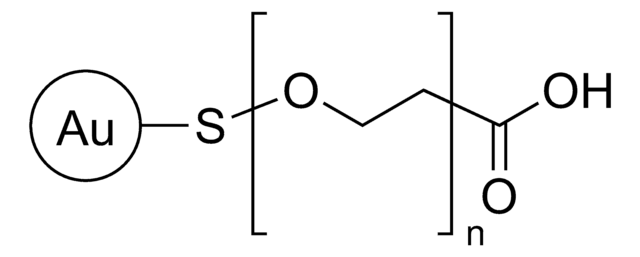Kluczowe dokumenty
753645
Gold nanoparticles
50 nm diameter, OD 1, stabilized suspension in 0.1 mM PBS, reactant free
Synonim(y):
Au NP, Gold colloid
About This Item
Polecane produkty
Poziom jakości
Postać
nanoparticles
suspension
opakowanie
poly bottle of 100 mL
poly bottle of 25 mL
warunki przechowywania
do not freeze
stężenie
~3.5E+10 particles/mL
OD
1
średnica
50 nm
λmaks.
531-535 nm
PDI
<0.2
temp. przechowywania
2-8°C
ciąg SMILES
[Au]
InChI
1S/Au
Klucz InChI
PCHJSUWPFVWCPO-UHFFFAOYSA-N
Szukasz podobnych produktów? Odwiedź Przewodnik dotyczący porównywania produktów
Opis ogólny
Zastosowanie
- As conductors in printable inks,
- In Photodynamic therapy,
- In drug delivery and biomarkers,
- As calorimetric sensor,
- In biological imaging,
Informacje prawne
Kod klasy składowania
12 - Non Combustible Liquids
Klasa zagrożenia wodnego (WGK)
nwg
Temperatura zapłonu (°F)
Not applicable
Temperatura zapłonu (°C)
Not applicable
Wybierz jedną z najnowszych wersji:
Masz już ten produkt?
Dokumenty związane z niedawno zakupionymi produktami zostały zamieszczone w Bibliotece dokumentów.
Klienci oglądali również te produkty
Produkty
Surface-enhanced Solar Energy Conversion Systems Using Gold and Silver Nanoparticles
Steven J. Oldenburg, Ph.D. provides an overview of lateral flow diagnostic assays and discusses the use of ultra-bright reporter particles based on the unique optical properties of gold nanoshells that significantly increase the sensitivity of lateral flow immunoassays.
Gold (Au) nanoparticles have tunable optical and electronic properties and are used in a number of applications including photovoltaics, sensors, drug delivery & catalysis.
Nanocząstki złota (Au) mają przestrajalne właściwości optyczne i elektroniczne i są wykorzystywane w wielu zastosowaniach, w tym w fotowoltaice, czujnikach, dostarczaniu leków i katalizie.
Nasz zespół naukowców ma doświadczenie we wszystkich obszarach badań, w tym w naukach przyrodniczych, materiałoznawstwie, syntezie chemicznej, chromatografii, analityce i wielu innych dziedzinach.
Skontaktuj się z zespołem ds. pomocy technicznej


